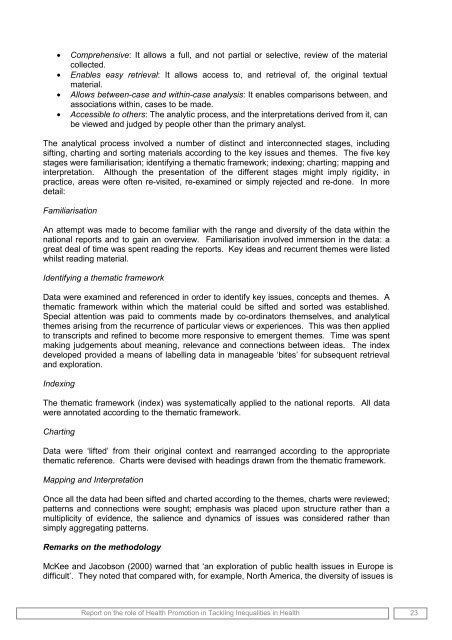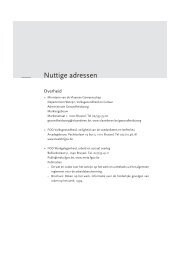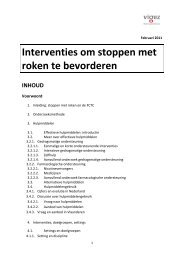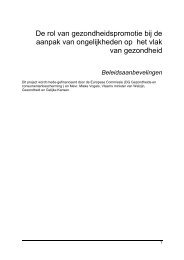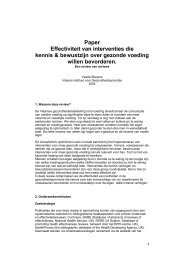Annex 1: Inventory of indicators from surveys and registries
Annex 1: Inventory of indicators from surveys and registries
Annex 1: Inventory of indicators from surveys and registries
You also want an ePaper? Increase the reach of your titles
YUMPU automatically turns print PDFs into web optimized ePapers that Google loves.
• Comprehensive: It allows a full, <strong>and</strong> not partial or selective, review <strong>of</strong> the material<br />
collected.<br />
• Enables easy retrieval: It allows access to, <strong>and</strong> retrieval <strong>of</strong>, the original textual<br />
material.<br />
• Allows between-case <strong>and</strong> within-case analysis: It enables comparisons between, <strong>and</strong><br />
associations within, cases to be made.<br />
• Accessible to others: The analytic process, <strong>and</strong> the interpretations derived <strong>from</strong> it, can<br />
be viewed <strong>and</strong> judged by people other than the primary analyst.<br />
The analytical process involved a number <strong>of</strong> distinct <strong>and</strong> interconnected stages, including<br />
sifting, charting <strong>and</strong> sorting materials according to the key issues <strong>and</strong> themes. The five key<br />
stages were familiarisation; identifying a thematic framework; indexing; charting; mapping <strong>and</strong><br />
interpretation. Although the presentation <strong>of</strong> the different stages might imply rigidity, in<br />
practice, areas were <strong>of</strong>ten re-visited, re-examined or simply rejected <strong>and</strong> re-done. In more<br />
detail:<br />
Familiarisation<br />
An attempt was made to become familiar with the range <strong>and</strong> diversity <strong>of</strong> the data within the<br />
national reports <strong>and</strong> to gain an overview. Familiarisation involved immersion in the data: a<br />
great deal <strong>of</strong> time was spent reading the reports. Key ideas <strong>and</strong> recurrent themes were listed<br />
whilst reading material.<br />
Identifying a thematic framework<br />
Data were examined <strong>and</strong> referenced in order to identify key issues, concepts <strong>and</strong> themes. A<br />
thematic framework within which the material could be sifted <strong>and</strong> sorted was established.<br />
Special attention was paid to comments made by co-ordinators themselves, <strong>and</strong> analytical<br />
themes arising <strong>from</strong> the recurrence <strong>of</strong> particular views or experiences. This was then applied<br />
to transcripts <strong>and</strong> refined to become more responsive to emergent themes. Time was spent<br />
making judgements about meaning, relevance <strong>and</strong> connections between ideas. The index<br />
developed provided a means <strong>of</strong> labelling data in manageable ‘bites’ for subsequent retrieval<br />
<strong>and</strong> exploration.<br />
Indexing<br />
The thematic framework (index) was systematically applied to the national reports. All data<br />
were annotated according to the thematic framework.<br />
Charting<br />
Data were ‘lifted’ <strong>from</strong> their original context <strong>and</strong> rearranged according to the appropriate<br />
thematic reference. Charts were devised with headings drawn <strong>from</strong> the thematic framework.<br />
Mapping <strong>and</strong> Interpretation<br />
Once all the data had been sifted <strong>and</strong> charted according to the themes, charts were reviewed;<br />
patterns <strong>and</strong> connections were sought; emphasis was placed upon structure rather than a<br />
multiplicity <strong>of</strong> evidence, the salience <strong>and</strong> dynamics <strong>of</strong> issues was considered rather than<br />
simply aggregating patterns.<br />
Remarks on the methodology<br />
McKee <strong>and</strong> Jacobson (2000) warned that ‘an exploration <strong>of</strong> public health issues in Europe is<br />
difficult’. They noted that compared with, for example, North America, the diversity <strong>of</strong> issues is<br />
Report on the role <strong>of</strong> Health Promotion in Tackling Inequalities in Health<br />
23


